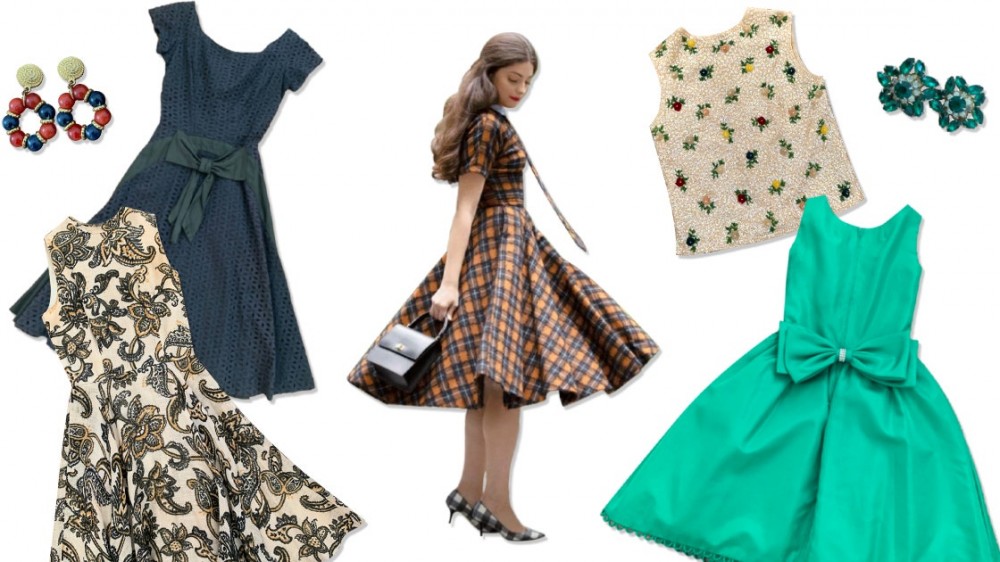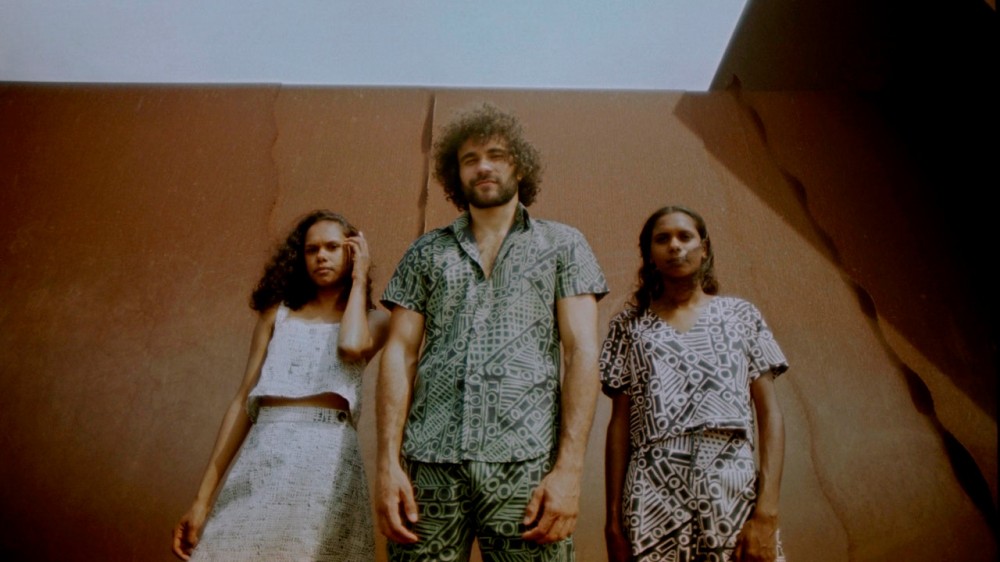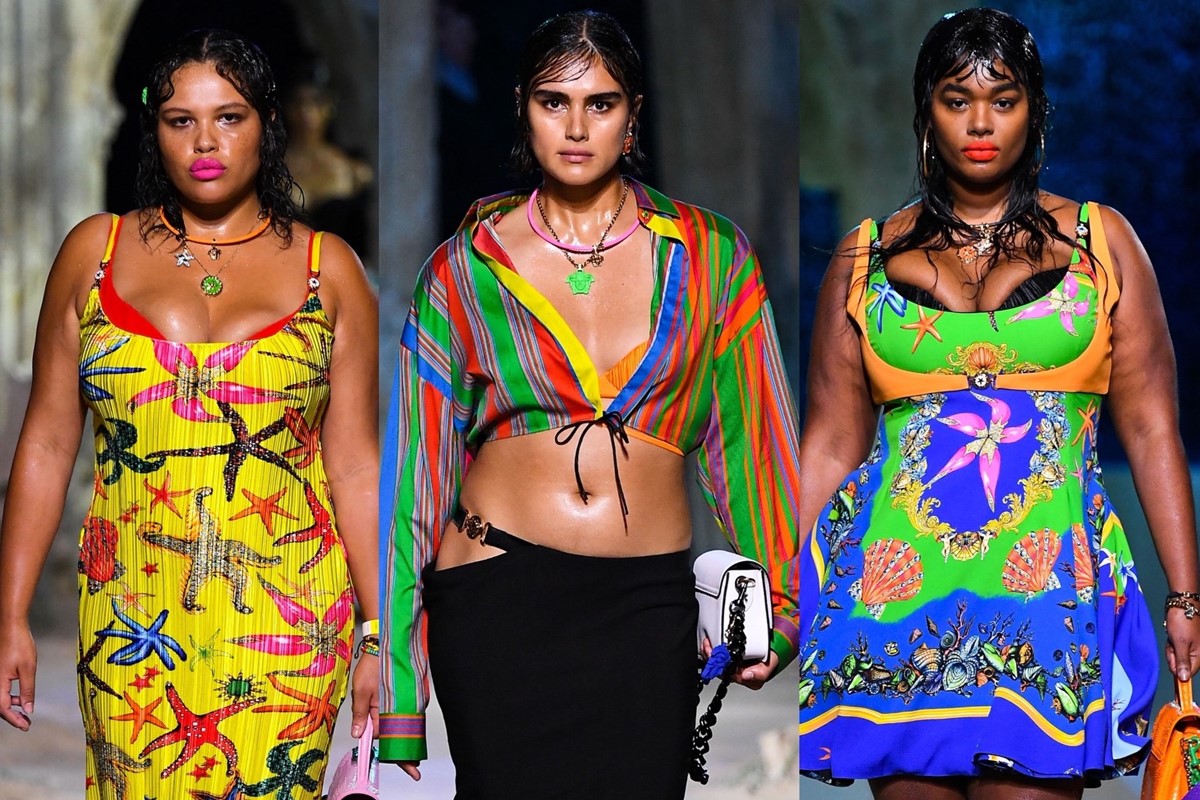
Why I’m Committing to Shopping Only Vintage in 2021
It all started with a Richard Avedon photo. I was 21, days into the first semester of my fashion history graduate program, and seated in a photography studies course. On the classroom projector was the model Renée, spinning on the streets of Paris in 1947 to the delight of some male passersby. Her Dior skirt catches the air, swirling like a luxurious meringue. Looking upon her impossibly elegant figure left me feeling dizzy with delight. The photo overwhelmed with its heady glamour. To my eyes, this was everything I wanted to be—poised, graceful, well-mannered, well-read, with the world wrapped around her red lacquered finger. I needed that skirt.
In my search for the perfect one that could spin like a ballerina in a music box, I took to the internet to purchase a sweet, black, high waisted, A-line Kate Spade skirt of a faux silk faille. I paired it with a classic white shirt. It didn’t not work but it was acres away from the vision I had in my mind. Only after I searched “real 1950s skirt” did I find what I was looking for and did I discover the glories of Etsy. Much more than knitted potholders and monogrammed bachelorette tchotchkes, the marketplace is vintage fashion heaven, where bygone trends live on. Page after page of mid-century circle skirts, specifically constructed to create the same volume and beautiful drape, appeared. It wasn’t New Look Dior, but it would do marvelously.
10 years later, I have a carefully curated closet full of vintage clothing designed to make me look like an Avedon heroine—Anne Fogarty’s prim day dresses, beaded numbers by Malcolm Starr, separates from Jonathan Logan. I’m not a numbers person, but if I had to dabble, I would estimate that 90% of all my clothing (excluding shoes, undergarments, sleepwear, and activewear) is either vintage or secondhand. Unwittingly and motivated purely by my obsession with an aesthetic, I had cobbled together a wardrobe with a relatively low environmental impact.
This understanding came only late last year, coinciding with the secondhand market’s rapid ascent to fashionableness—2020 saw the online resale market grow by 27%. I’d see my favorite environmental advocate, Lauren Singer behind @TrashIsForTossers, explain to her followers that her new dress was secondhand and therefore fit her laudable zero-waste lifestyle. Same, but different? I thought to myself. Cast in one light, I’m a girl with one too many wasp-waisted cocktail dresses. Cast in another, am I an eco-warrior? I began to wonder if I could commit to a year of shopping exclusively in the secondary market and devised a plot to only shop vintage and resale for the rest of the year. Excluding the aforementioned categories of clothing that, for me, don’t have a vintage appeal for reasons relating to hygiene, any new wardrobe acquisitions in 2021 would be not-new. Though it’s worth noting that it is possible to purchase never worn products in the secondary market, so my resolution does come with some leeway.
“I think you’re giving yourself a very easy resolution,” a friend tells me after I present to her my personal challenge. “Remember when I asked to borrow a dress and you said ‘anything but vintage?’ Your entire closet was basically off-limits.” She wasn’t wrong, but I would stick with it nonetheless because I anticipated a win-win. I relished the opportunity to promote secondhand as something other than second best. And also, to substantiate my vintage habits as something other than pure frivolity. I set out to understand the benefits of shopping in the secondary market—consignment, resale, vintage, and thrift shops, and for me, my granny’s closet.
I connect with Charlotte Turner, head of sustainable fashion & textiles at Eco-Age—Livia Firth’s sustainability communications and consulting agency. “The average consumer is buying 60% more but keeping each garment for half as long,” she tells me. “We’re also seeing a massive rise in people depositing unwanted clothing in recycling collection boxes—but we don’t currently have the technology and infrastructure to recycle it all, so a lot actually ends up going to landfill or incineration.” In an estimation by the Clean Clothes Campaign 3 out of 5 garments produced in 2018 by the global fashion industry will end up in a landfill within a year. It’s a sobering statistic and one made even harsher when you take into account that synthetic textiles are mostly non-biodegradable. And this is of course the tip of the iceberg; there are significant strains put on the environment in the harvesting, dyeing, and manufacturing of textiles and fashion. According to a 2019 report published by the House of Commons Environmental Audit Committee, “textile production contributes more to climate change than international aviation and shipping combined.” This all produces a different kind of overwhelm than the bout I experienced in my photography class years ago. For an industry fueled by fantasy and promise, fashion’s reality stands in stark contrast.
I fully appreciate that not everyone dreams of dressing like they’re being romanced by Don Draper, and shopping vintage and secondhand has its limitations. Size being a major issue and hygiene being another. The smaller the year of origin, the smaller the garment and studies tell us women are larger now than they were 50 years ago. And, of course, if I’m shopping and I see something that I like that’s not my size, I’m out of luck. Vintage’s one-off nature means what you see—size, stains, rips, bad alterations, and all—is what you get. But the broader world of resale is slowly becoming more inclusive.
Regarding size, I call up Sasha Skoda, head of women’s at The RealReal—the mostly web-based wunderkammer for all things secondhand—to ask her about size and the secondary market. “We actually have data that shows that pieces that are in larger sizes sell faster than items in other sizes. And I think that just speaks to the demand that exists in the market,” she says. “It's challenging for The RealReal because we're not producing our own clothing and able to meet the demand that we see in the market. But we are always searching for new brands that are size inclusive that we can add to our designer directory.” Of course, The RealReal is not alone. Etsy, eBay, thredUP, Poshmark, and more are wonderful marketplaces with merchandise assortments operated for the people, by the people. The RealReal tells me that during the pandemic, there’s been a 27% increase in new consignors. It seems the stigma around previously worn garb is a vanishing one and millennials and subsequent generations are embracing it with open arms. She also notes that as more people become consignors and participate in the circular economy, the space becomes more diverse.
It’s not lost on me that avoiding shopping altogether is point-blank the obvious way to make an impact and secondhand is just the happy medium. It’s hard to quantify the real benefits of shopping the secondary market, but The RealReal does make an attempt. As both a consignor and a shopper, I have access to metrics of my own shopping history on the site. The figures are estimates generated by a calculator developed by TRR in collaboration with the environmental consulting firm Shift Advantage, World Resources Institute, and the Ellen MacArthur Foundation. Apparently, with my consignments alone, I have saved 640 liters of water and 23.25 kilograms of carbon. The figures reassure me that my undertaking, relatively small as it is, will still make a difference.
One week into January, so far so good. I haven’t bought anything for myself, yet. My first purchase seems to carry a bit of weight. I ask Skoda if she has any advice for me. “I would say to not stress out too much about it. I think it’s a heroic effort to try to have a purely pre-owned wardrobe, but if that just that doesn't feel possible or you feel pulled to buy a piece in the primary market, purchase smart and purchase luxury—it will allow the items to have a longer life cycle.” She continues, “And think about what you might do with that when you're done with it because there's more than one way to participate in the circular economy.”
On Instagram, I recently connected with the Texas-based, just-opened vintage shop, Lieu Vintage. Hannah Collazo, the owner, had successfully completed a year of vintage shopping. How was it? “Opting out of buying any new clothes for a year was not difficult, it just took a tiny bit more energy—to look for pieces at vintage stores, monitor online auctions, and put together new outfits from clothes I already had in my closet. However, that energy yielded a lot more creativity and avoided quite a lot of textile waste,” she says. I ask Collazo, does she think my own attempt was feasible? “Wholeheartedly, yes.” Two weeks down, 50 to go.



